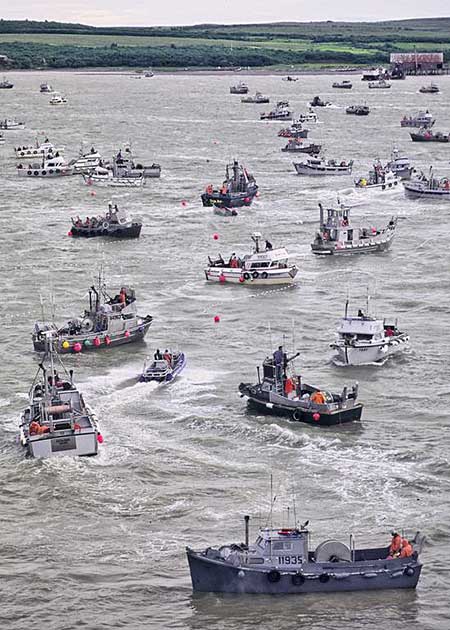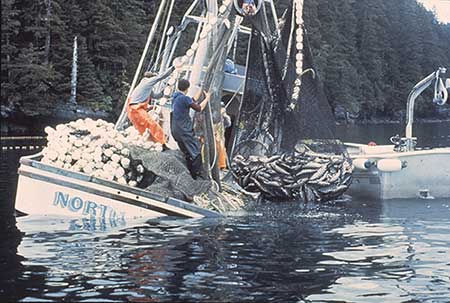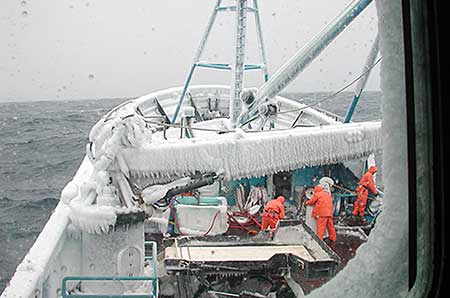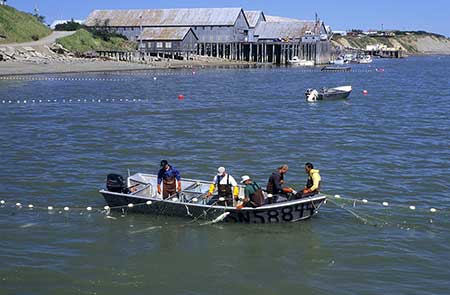Alaska Fish & Wildlife News
November 2022
Fatality-free Year for Alaska Commercial Fishing

No one died commercial fishing in Alaska over the past year. Fishing is a famously dangerous line of work, and this is remarkable news. This happened only once before, in 2015, but it may well happen again. Better gear, industry oversight, and safer practices are improving the odds for those at sea.
The Coast Guard 17th District Commercial Fishing Vessel Safety office reported the news in late October, 2022. These statistics are measured in the federal fiscal year, which runs Oct. 1 through Sept. 30. An operational fatality is defined as a death occurring as a result of an incident at sea, which tend to fall into three categories: a man overboard, a sunken or lost vessel, or an on-deck accident with gear or machinery.
“I give most all the credit to the fishing industry when it comes to staying safe and alive,” said Scott Wilwert, Commercial Fishing Vessel Safety Coordinator, Coast Guard 17th District. “The efforts of Coast Guard fishing vessel examiners and maritime training organizations also play a vital role in preparing fishermen to survive an incident at sea and utilize the equipment they have onboard during an emergency.”
The safety trend is noteworthy. Between 1980 and 1988, an average of 31 fishermen died in Alaska each year. At the end of that deadly decade, things started getting better, and the number of fishing fatalities has decreased 73 percent since the early 1990s. Between 2000-2009, 13 fishermen died per year on average. Between 2010 and 2015, that had fallen to about seven per year – with 2015 being the first standout with no fatalities.
Commercial fishing became safer for a variety of reasons, including the switch from intense, derby style openings to fishing quotas (giving fishermen more choice when they go and how to spread out the work), and fewer people working in the most dangerous crab fisheries. But safety requirements and practices -and training - made a profound difference.
In the 1990s, immersion suits and life rafts became required equipment. Safety drills and first aid training were required for crewmembers. The Coast Guard began conducting voluntary dockside safety inspections, a program that was particularly successful in Alaska, where dockside exams were conducted at four and a half times the national average. In 2015, dockside exams became mandatory for all commercial vessels that fish beyond three miles from shore.

Two pieces of gear have also contributed: The EPIRB - an Emergency Position Indicating Radio Beacon – was required by the Commercial Fishing Industry Vessel Safety Act (CFIVSA) for vessels that fish more than three miles offshore. The automatic signal guides rescuers in the event of an emergency.
Another is improvement to – and the more widespread use of – Personal Floatation Devices (PFD). Some of the credit for that goes to the National Institute of Occupational Safety and Health (NIOSH). A federal agency within the Department of Health and Human Services, NIOSH has studied fishing safety to reduce injuries and fatalities since 1991.
The leading cause of death for commercial fishermen is “vessel disasters,” boats capsizing or sinking. Man overboard fatalities are the second leading cause of death. Between 2000 and 2014 there were 210 fatal falls overboard in the United States and not one of the victims was wearing a personal flotation device (PFD) when they drowned. In Alaska, none of the fishermen who drowned after falling overboard were wearing life jackets.
Fishermen cite several reasons for not wearing life jackets – they’re uncomfortable, they restrict movement when you’re working, and they create entanglement hazards.
NIOSH enlisted the cooperation of fishermen in Alaska to address this: different PFDs were worn for 30 days on deck by 400 fishermen in four different fisheries, so “wearable” PFDs could be identified. Fishermen evaluated the PFDs and NIOSH published and distributed the findings. NIOSH worked to help fishermen find PFDs they would actually wear.

One style is particularly convenient, a PFD that is built into the suspenders in bib-type rain gear. The suspenders just feel a little more padded, but they inflate automatically if someone hits the water.
On-deck injuries account for the third leading cause of death, but it’s much smaller than the other two – just 12 percent. One thing that’s helping reduce on-deck injuries is the growing use of emergency stop devices on deck machinery.
Mandatory safety gear isn’t much good if fishermen don’t know how to use it. One of the maritime training organizations that safety coordinator Scott Wilwert referred to is the Alaska Marine Safety Education Association (AMSEA), which teaches mariners how to deal with emergencies, use their gear, and assess risks. AMSEA is based in Sitka in Southeast Alaska and has trained more than 200,000 people since 1985. The group works mostly in Alaska but also on all coasts around the United States, and provides hands-on training: fishermen put on survival suits and get in cold water, they light flares and put out fires, they practice mayday calls and readying life rafts. In debriefing after incidents at sea, crew members report that the training paid off.
Wilwert said the Coast Guard will keep working with the commercial fishing industry to make fishing safer and continue this downward trend in fishing fatalities.
“We definitely want to keep this momentum going through calendar year 2022 and beyond,” said Wilwert. “Dangers are ever present in the fishing industry and are the reason we’re encouraging mariners to remain vigilant when it comes to crew training and safety.”
Fishing vessel owners and operators are reminded of the importance of properly maintaining their vessel’s lifesaving equipment, ensuring that all crewmembers working on deck are wearing personal floatation devices, and conducting regular shipboard drills to maintain the crew’s proficiency at operating shipboard emergency equipment.

The Coast Guard encourages owners and operators to review and be knowledgeable of the general maintenance and upkeep of their vessels. Minor hull leaks and machinery failures should be properly repaired and documented. Vessel operators need to be fully aware of the operating constraints that may pertain to their vessels, including awareness of the risks of both overloading a vessel, icing, and operating outside the restrictions of their stability letters as well as the crew’s ability.
NIOSH and commercial fishing safety
AMSEA and upcoming courses in Alaska
The North Pacific Vessel Owners Association (NPFVOA)
If you are an owner or operator of a fishing vessel that needs or wants a Coast Guard dockside safety exam, one can be scheduled by contacting the nearest Coast Guard Sector or Marine Safety Office below:
Ketchikan: (907) 225-4496
Sitka: (907) 966-5454
Juneau: (907) 463-2448
Valdez: (907) 835-7223
Homer: (907) 235-3292
Kodiak: (907) 486-5918
Unalaska/Dutch Harbor: (907)-581-3466
Anchorage: (907)-428-4179
You can also create a pre-examination custom checklist for your vessel on The Checklist Generator found at: www.fishsafewest.info.
Questions or concerns regarding dockside safety exams can be directed to Scott Wilwert at (907) 463-2810.
Subscribe to be notified about new issues
Receive a monthly notice about new issues and articles.
